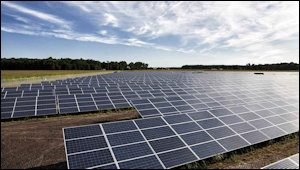by James A. Bacon
Governor Terry McAuliffe traveled to Lexington yesterday to flip the switch on Virginia’s first community solar project, installed by the tiny BARC Electrical Cooperative.
“BARC’s community solar project is an excellent model for stabilizing and reducing energy costs, while delivering clean solar power to a large segment of households on the grid,” McAuliffe said at the commissioning ceremony. “”I do hope this is a model for the rest of our utilities.”
With a three-acre bank of solar panels generating up to 550 kilowatts, BARC will provide 25% of average monthly consumption to 212 residential and business customers in a service area encompassing Alleghany, Augusta, Bath, Highland and Rockbridge counties, reports the Roanoke Times. Another 25 customers are on the waiting list for when the project expands.
The electricity generated by the solar farm will replace power that BARC would have purchased from the wholesale electricity market.
BARC, a rural electrical cooperative serving more than 12,500 metered customers, had seen considerable interest among members in rooftop solar but observed that little was happening. Either upfront costs were too high, or there were physical barriers such as shading. But building utility-scale solar changed the equation. BARC had the heft to line up financing, it could acquire a shade-free location to place its solar panels, and it enjoyed economies of scale in installation. The coop also acquired a $500,000 grant from the Appalachian Regional Commission (ARC) and another from the U.S. Department of Agriculture to offset upfront financing costs.
CEO Michael Keyser explained the business model to Southeast Energy News:
We settled on a fixed-rate model because we determined one of the key barriers to solar is the upfront cost. It was also vitally important that the project self-sustain its own growth. We need to get the levelized cost of energy low enough so that a portion of every subscription would be set aside in a revolving fund to pay for project expansion. As long as there is a waiting list, like right now, the project will continue to pay for its own growth. It’s tremendous.
[The size of the project] was essentially a balancing act between building a system large enough to serve a meaningful number of members, while keeping the total capital costs manageable so that it was not detrimental to our balance sheet.
The value proposition to customers? Subscribers will pay $5 more per month for that 25% block of electricity consumption. But the charge for that block will remain fixed for 20 years, not subject to rate increases.
Bacon’s bottom line: The project required significant subsidies in the form of federal grants — the ARC grant amounted to more than $2,300 per customer. Without the grants, it is unlikely that solar energy in this case would have been cost competitive with the wholesale electricity market. It’s not clear if the solar farm also benefited from federal tax credits. Nothing I have read so far indicated the existence of an intermediary legal entity that would have utilized the tax credits, however, and BARC is a non-profit coop, so it could not have employed them. If I’m right and BARC did in fact build the facility without the tax credits that most other solar projects require to obtain financing, that is a significant accomplishment.
Also, it is interesting to see that so many customers are willing to pay a $5-per-month premium either to be “green” or to lock in a fixed price for electricity for 20 years. The beauty of the project is that customers subscribe voluntarily. No one is being coerced into paying higher rates for a service they don’t want.



